Analyzing the Influence of Culture in International Marketing
VerifiedAdded on 2021/05/31
|8
|1459
|98
Report
AI Summary
This report delves into the significant influence of cultural dimensions on international marketing strategies. It highlights the critical importance of cultural sensitivity for companies entering new markets, using the P&G Japan venture as a cautionary example. The report analyzes cultural models, notably Hofstede and Trompenaars, emphasizing their dimensions and impact on marketing activities. It explores how cultural values, attitudes, and behaviors affect marketing mix elements and market entry strategies, providing examples like Nike in China and Tourism Australia's campaign. The report underscores that understanding cultural nuances is vital for effective international marketing, influencing product offerings, advertising, and overall business success. The report also highlights the importance of considering cultural factors in leadership and technology, concluding that marketers need skills beyond domestic territories.

MARKETING
Influence of Culture in International Market
Student’s name
Name of the Institute
Influence of Culture in International Market
Student’s name
Name of the Institute
Paraphrase This Document
Need a fresh take? Get an instant paraphrase of this document with our AI Paraphraser
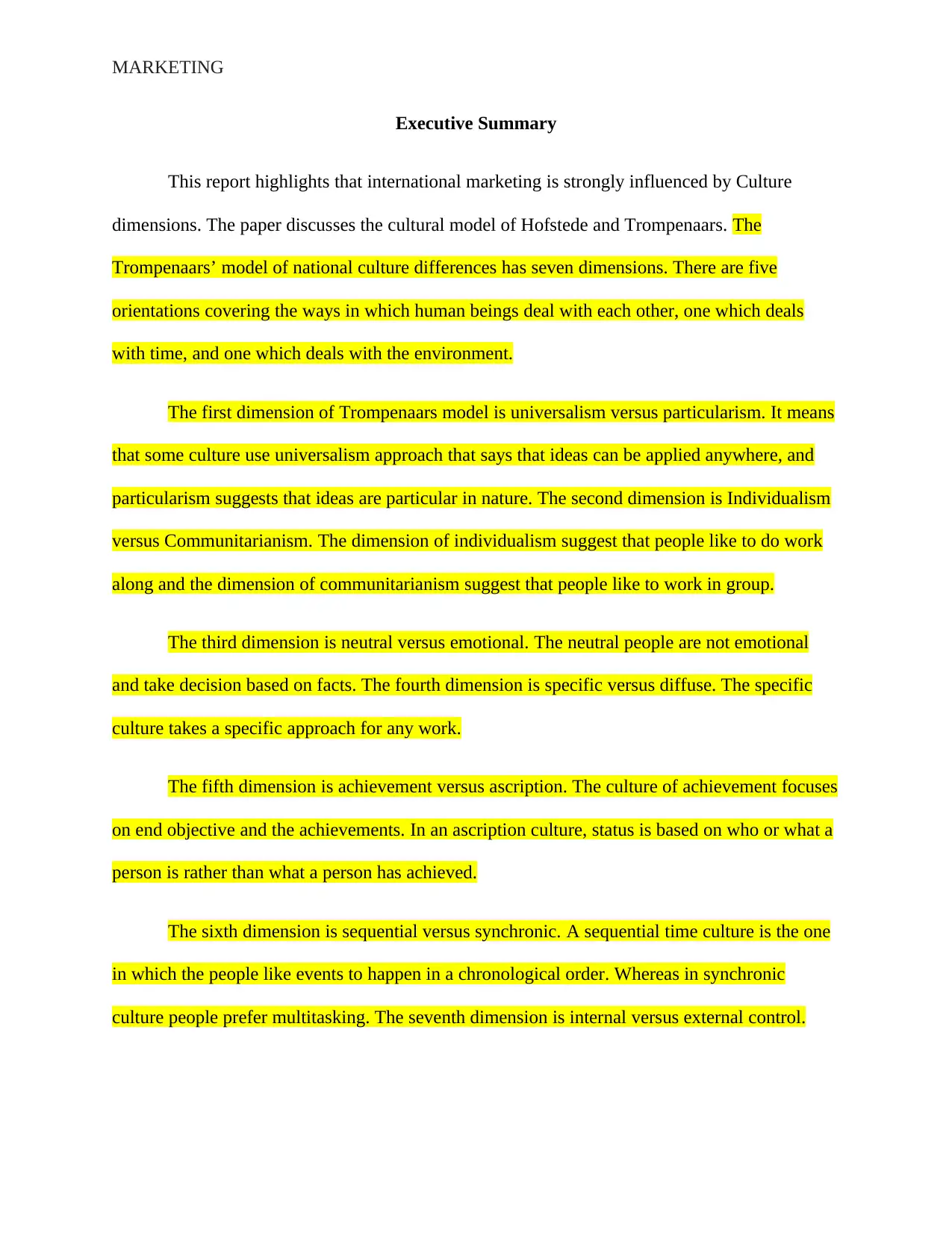
MARKETING
Executive Summary
This report highlights that international marketing is strongly influenced by Culture
dimensions. The paper discusses the cultural model of Hofstede and Trompenaars. The
Trompenaars’ model of national culture differences has seven dimensions. There are five
orientations covering the ways in which human beings deal with each other, one which deals
with time, and one which deals with the environment.
The first dimension of Trompenaars model is universalism versus particularism. It means
that some culture use universalism approach that says that ideas can be applied anywhere, and
particularism suggests that ideas are particular in nature. The second dimension is Individualism
versus Communitarianism. The dimension of individualism suggest that people like to do work
along and the dimension of communitarianism suggest that people like to work in group.
The third dimension is neutral versus emotional. The neutral people are not emotional
and take decision based on facts. The fourth dimension is specific versus diffuse. The specific
culture takes a specific approach for any work.
The fifth dimension is achievement versus ascription. The culture of achievement focuses
on end objective and the achievements. In an ascription culture, status is based on who or what a
person is rather than what a person has achieved.
The sixth dimension is sequential versus synchronic. A sequential time culture is the one
in which the people like events to happen in a chronological order. Whereas in synchronic
culture people prefer multitasking. The seventh dimension is internal versus external control.
Executive Summary
This report highlights that international marketing is strongly influenced by Culture
dimensions. The paper discusses the cultural model of Hofstede and Trompenaars. The
Trompenaars’ model of national culture differences has seven dimensions. There are five
orientations covering the ways in which human beings deal with each other, one which deals
with time, and one which deals with the environment.
The first dimension of Trompenaars model is universalism versus particularism. It means
that some culture use universalism approach that says that ideas can be applied anywhere, and
particularism suggests that ideas are particular in nature. The second dimension is Individualism
versus Communitarianism. The dimension of individualism suggest that people like to do work
along and the dimension of communitarianism suggest that people like to work in group.
The third dimension is neutral versus emotional. The neutral people are not emotional
and take decision based on facts. The fourth dimension is specific versus diffuse. The specific
culture takes a specific approach for any work.
The fifth dimension is achievement versus ascription. The culture of achievement focuses
on end objective and the achievements. In an ascription culture, status is based on who or what a
person is rather than what a person has achieved.
The sixth dimension is sequential versus synchronic. A sequential time culture is the one
in which the people like events to happen in a chronological order. Whereas in synchronic
culture people prefer multitasking. The seventh dimension is internal versus external control.
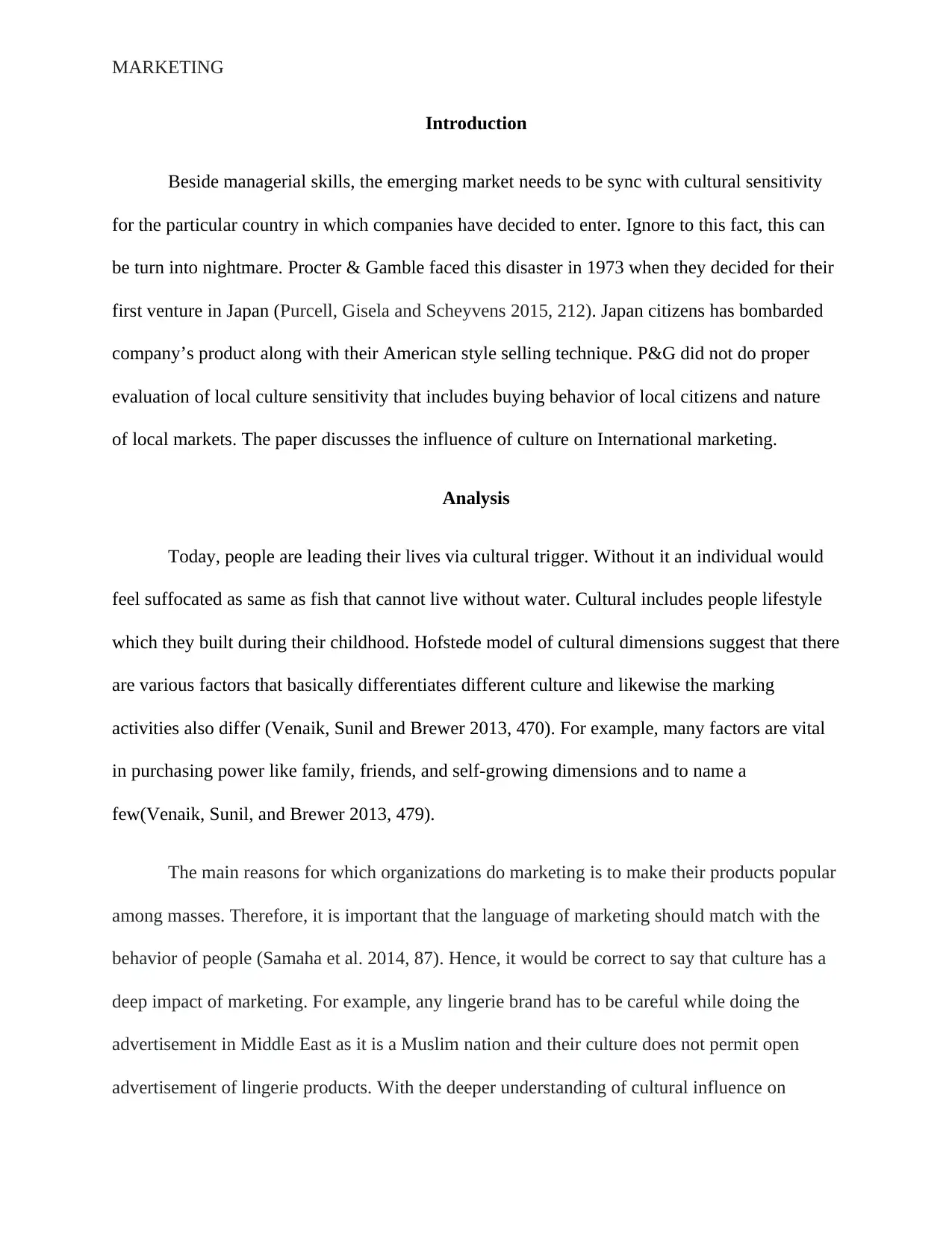
MARKETING
Introduction
Beside managerial skills, the emerging market needs to be sync with cultural sensitivity
for the particular country in which companies have decided to enter. Ignore to this fact, this can
be turn into nightmare. Procter & Gamble faced this disaster in 1973 when they decided for their
first venture in Japan (Purcell, Gisela and Scheyvens 2015, 212). Japan citizens has bombarded
company’s product along with their American style selling technique. P&G did not do proper
evaluation of local culture sensitivity that includes buying behavior of local citizens and nature
of local markets. The paper discusses the influence of culture on International marketing.
Analysis
Today, people are leading their lives via cultural trigger. Without it an individual would
feel suffocated as same as fish that cannot live without water. Cultural includes people lifestyle
which they built during their childhood. Hofstede model of cultural dimensions suggest that there
are various factors that basically differentiates different culture and likewise the marking
activities also differ (Venaik, Sunil and Brewer 2013, 470). For example, many factors are vital
in purchasing power like family, friends, and self-growing dimensions and to name a
few(Venaik, Sunil, and Brewer 2013, 479).
The main reasons for which organizations do marketing is to make their products popular
among masses. Therefore, it is important that the language of marketing should match with the
behavior of people (Samaha et al. 2014, 87). Hence, it would be correct to say that culture has a
deep impact of marketing. For example, any lingerie brand has to be careful while doing the
advertisement in Middle East as it is a Muslim nation and their culture does not permit open
advertisement of lingerie products. With the deeper understanding of cultural influence on
Introduction
Beside managerial skills, the emerging market needs to be sync with cultural sensitivity
for the particular country in which companies have decided to enter. Ignore to this fact, this can
be turn into nightmare. Procter & Gamble faced this disaster in 1973 when they decided for their
first venture in Japan (Purcell, Gisela and Scheyvens 2015, 212). Japan citizens has bombarded
company’s product along with their American style selling technique. P&G did not do proper
evaluation of local culture sensitivity that includes buying behavior of local citizens and nature
of local markets. The paper discusses the influence of culture on International marketing.
Analysis
Today, people are leading their lives via cultural trigger. Without it an individual would
feel suffocated as same as fish that cannot live without water. Cultural includes people lifestyle
which they built during their childhood. Hofstede model of cultural dimensions suggest that there
are various factors that basically differentiates different culture and likewise the marking
activities also differ (Venaik, Sunil and Brewer 2013, 470). For example, many factors are vital
in purchasing power like family, friends, and self-growing dimensions and to name a
few(Venaik, Sunil, and Brewer 2013, 479).
The main reasons for which organizations do marketing is to make their products popular
among masses. Therefore, it is important that the language of marketing should match with the
behavior of people (Samaha et al. 2014, 87). Hence, it would be correct to say that culture has a
deep impact of marketing. For example, any lingerie brand has to be careful while doing the
advertisement in Middle East as it is a Muslim nation and their culture does not permit open
advertisement of lingerie products. With the deeper understanding of cultural influence on
⊘ This is a preview!⊘
Do you want full access?
Subscribe today to unlock all pages.

Trusted by 1+ million students worldwide
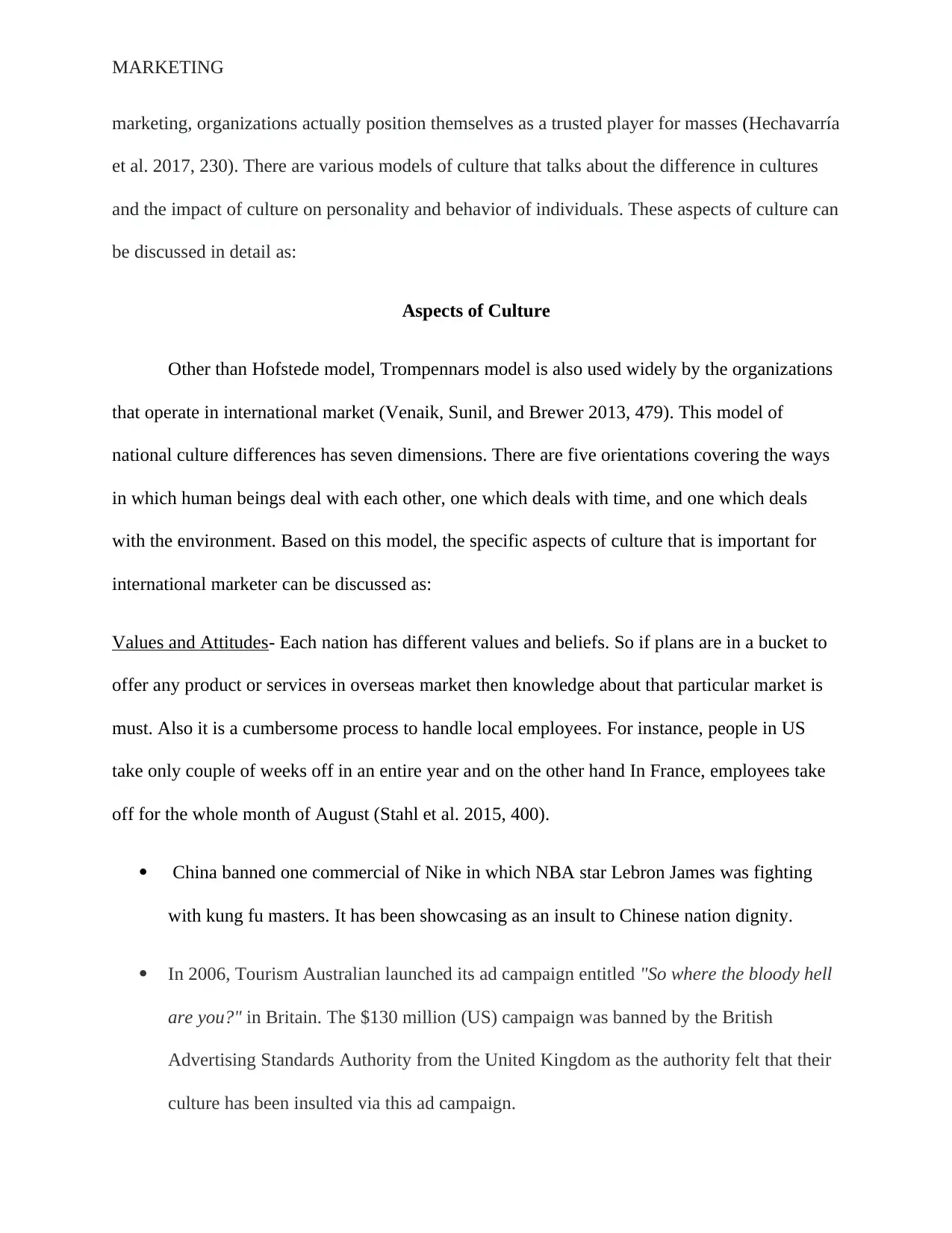
MARKETING
marketing, organizations actually position themselves as a trusted player for masses (Hechavarría
et al. 2017, 230). There are various models of culture that talks about the difference in cultures
and the impact of culture on personality and behavior of individuals. These aspects of culture can
be discussed in detail as:
Aspects of Culture
Other than Hofstede model, Trompennars model is also used widely by the organizations
that operate in international market (Venaik, Sunil, and Brewer 2013, 479). This model of
national culture differences has seven dimensions. There are five orientations covering the ways
in which human beings deal with each other, one which deals with time, and one which deals
with the environment. Based on this model, the specific aspects of culture that is important for
international marketer can be discussed as:
Values and Attitudes- Each nation has different values and beliefs. So if plans are in a bucket to
offer any product or services in overseas market then knowledge about that particular market is
must. Also it is a cumbersome process to handle local employees. For instance, people in US
take only couple of weeks off in an entire year and on the other hand In France, employees take
off for the whole month of August (Stahl et al. 2015, 400).
China banned one commercial of Nike in which NBA star Lebron James was fighting
with kung fu masters. It has been showcasing as an insult to Chinese nation dignity.
In 2006, Tourism Australian launched its ad campaign entitled "So where the bloody hell
are you?" in Britain. The $130 million (US) campaign was banned by the British
Advertising Standards Authority from the United Kingdom as the authority felt that their
culture has been insulted via this ad campaign.
marketing, organizations actually position themselves as a trusted player for masses (Hechavarría
et al. 2017, 230). There are various models of culture that talks about the difference in cultures
and the impact of culture on personality and behavior of individuals. These aspects of culture can
be discussed in detail as:
Aspects of Culture
Other than Hofstede model, Trompennars model is also used widely by the organizations
that operate in international market (Venaik, Sunil, and Brewer 2013, 479). This model of
national culture differences has seven dimensions. There are five orientations covering the ways
in which human beings deal with each other, one which deals with time, and one which deals
with the environment. Based on this model, the specific aspects of culture that is important for
international marketer can be discussed as:
Values and Attitudes- Each nation has different values and beliefs. So if plans are in a bucket to
offer any product or services in overseas market then knowledge about that particular market is
must. Also it is a cumbersome process to handle local employees. For instance, people in US
take only couple of weeks off in an entire year and on the other hand In France, employees take
off for the whole month of August (Stahl et al. 2015, 400).
China banned one commercial of Nike in which NBA star Lebron James was fighting
with kung fu masters. It has been showcasing as an insult to Chinese nation dignity.
In 2006, Tourism Australian launched its ad campaign entitled "So where the bloody hell
are you?" in Britain. The $130 million (US) campaign was banned by the British
Advertising Standards Authority from the United Kingdom as the authority felt that their
culture has been insulted via this ad campaign.
Paraphrase This Document
Need a fresh take? Get an instant paraphrase of this document with our AI Paraphraser
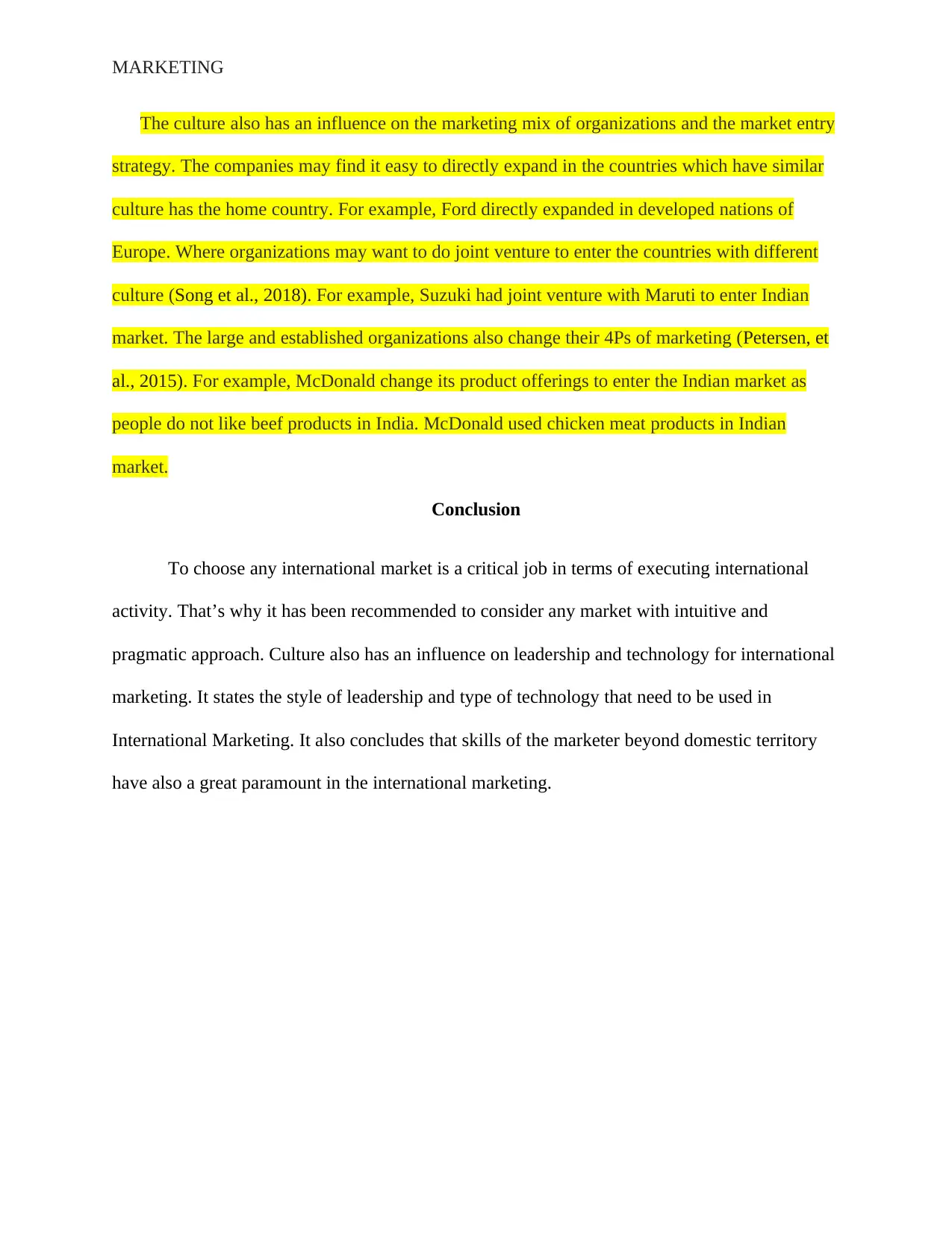
MARKETING
The culture also has an influence on the marketing mix of organizations and the market entry
strategy. The companies may find it easy to directly expand in the countries which have similar
culture has the home country. For example, Ford directly expanded in developed nations of
Europe. Where organizations may want to do joint venture to enter the countries with different
culture (Song et al., 2018). For example, Suzuki had joint venture with Maruti to enter Indian
market. The large and established organizations also change their 4Ps of marketing (Petersen, et
al., 2015). For example, McDonald change its product offerings to enter the Indian market as
people do not like beef products in India. McDonald used chicken meat products in Indian
market.
Conclusion
To choose any international market is a critical job in terms of executing international
activity. That’s why it has been recommended to consider any market with intuitive and
pragmatic approach. Culture also has an influence on leadership and technology for international
marketing. It states the style of leadership and type of technology that need to be used in
International Marketing. It also concludes that skills of the marketer beyond domestic territory
have also a great paramount in the international marketing.
The culture also has an influence on the marketing mix of organizations and the market entry
strategy. The companies may find it easy to directly expand in the countries which have similar
culture has the home country. For example, Ford directly expanded in developed nations of
Europe. Where organizations may want to do joint venture to enter the countries with different
culture (Song et al., 2018). For example, Suzuki had joint venture with Maruti to enter Indian
market. The large and established organizations also change their 4Ps of marketing (Petersen, et
al., 2015). For example, McDonald change its product offerings to enter the Indian market as
people do not like beef products in India. McDonald used chicken meat products in Indian
market.
Conclusion
To choose any international market is a critical job in terms of executing international
activity. That’s why it has been recommended to consider any market with intuitive and
pragmatic approach. Culture also has an influence on leadership and technology for international
marketing. It states the style of leadership and type of technology that need to be used in
International Marketing. It also concludes that skills of the marketer beyond domestic territory
have also a great paramount in the international marketing.

MARKETING
References
Hechavarría, Diana M., Siri A. Terjesen, Amy E. Ingram, Maija Renko, Rachida Justo, and
Amanda Elam. "Taking care of business: the impact of culture and gender on entrepreneurs’
blended value creation goals." Small Business Economics 48, no. 1 (2017): 225-257.
Petersen, J. Andrew, Tarun Kushwaha, and V. Kumar. "Marketing communication strategies and
consumer financial decision making: The role of national culture." Journal of Marketing 79, no.
1 (2015): 44-63.
Stahl, Günter K., and Rosalie L. Tung. "Towards a more balanced treatment of culture in
international business studies: The need for positive cross-cultural scholarship." Journal of
International Business Studies 46, no. 4 (2015): 391-414.
Samaha, Stephen A., Joshua T. Beck, and Robert W. Palmatier. "The role of culture in
international relationship marketing." Journal of Marketing 78, no. 5 (2014): 78-98.
Song, Reo, Sangkil Moon, Haipeng Allan Chen, and Mark B. Houston. "When marketing
strategy meets culture: the role of culture in product evaluations." Journal of the Academy of
Marketing Science 46, no. 3 (2018): 384-402.
Venaik, Sunil, and Paul Brewer. "Critical issues in the Hofstede and GLOBE national culture
models." International Marketing Review 30, no. 5 (2013): 469-482.
References
Hechavarría, Diana M., Siri A. Terjesen, Amy E. Ingram, Maija Renko, Rachida Justo, and
Amanda Elam. "Taking care of business: the impact of culture and gender on entrepreneurs’
blended value creation goals." Small Business Economics 48, no. 1 (2017): 225-257.
Petersen, J. Andrew, Tarun Kushwaha, and V. Kumar. "Marketing communication strategies and
consumer financial decision making: The role of national culture." Journal of Marketing 79, no.
1 (2015): 44-63.
Stahl, Günter K., and Rosalie L. Tung. "Towards a more balanced treatment of culture in
international business studies: The need for positive cross-cultural scholarship." Journal of
International Business Studies 46, no. 4 (2015): 391-414.
Samaha, Stephen A., Joshua T. Beck, and Robert W. Palmatier. "The role of culture in
international relationship marketing." Journal of Marketing 78, no. 5 (2014): 78-98.
Song, Reo, Sangkil Moon, Haipeng Allan Chen, and Mark B. Houston. "When marketing
strategy meets culture: the role of culture in product evaluations." Journal of the Academy of
Marketing Science 46, no. 3 (2018): 384-402.
Venaik, Sunil, and Paul Brewer. "Critical issues in the Hofstede and GLOBE national culture
models." International Marketing Review 30, no. 5 (2013): 469-482.
⊘ This is a preview!⊘
Do you want full access?
Subscribe today to unlock all pages.

Trusted by 1+ million students worldwide
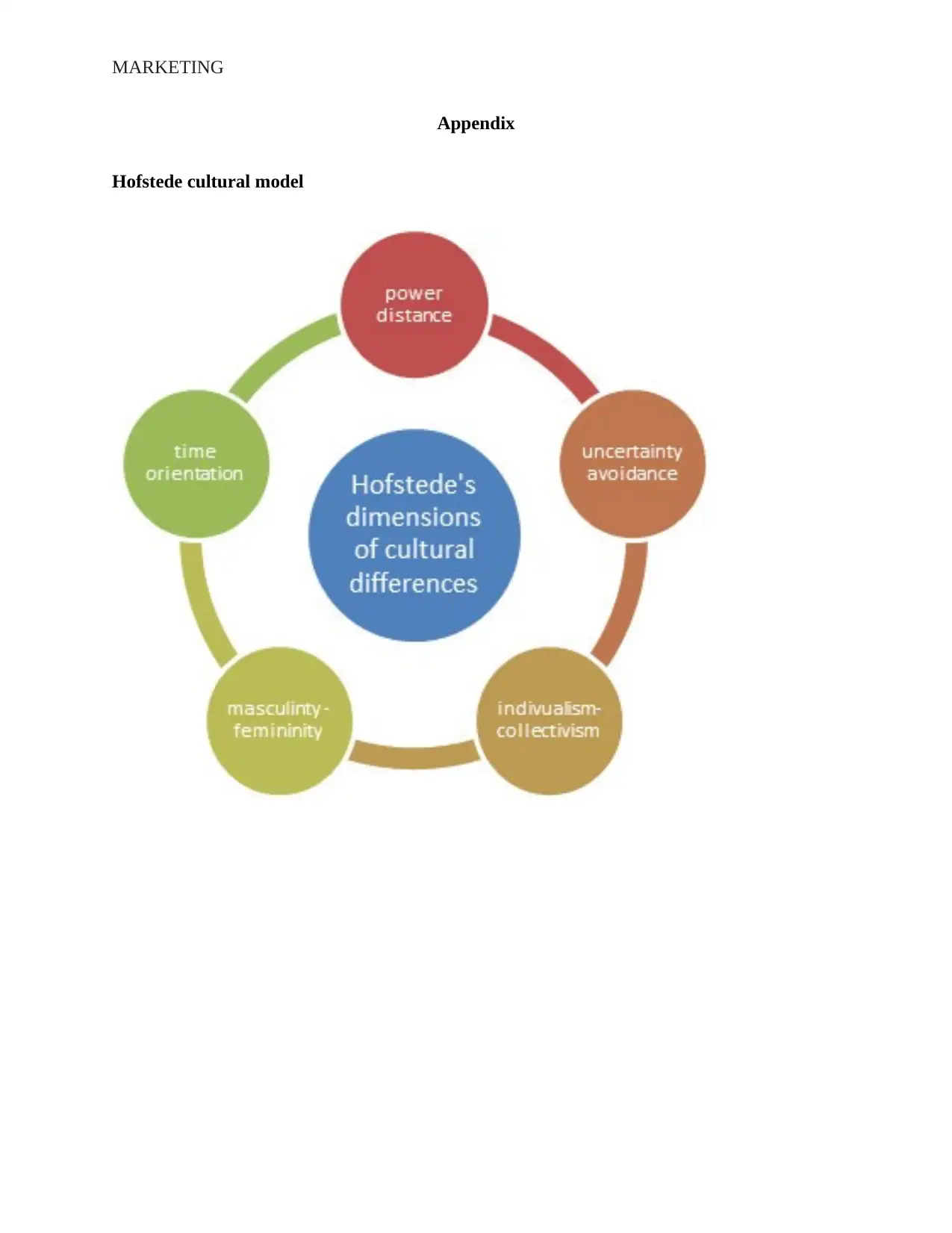
MARKETING
Appendix
Hofstede cultural model
Appendix
Hofstede cultural model
Paraphrase This Document
Need a fresh take? Get an instant paraphrase of this document with our AI Paraphraser

MARKETING
Trompennars model of national culture
Trompennars model of national culture
1 out of 8
Related Documents
Your All-in-One AI-Powered Toolkit for Academic Success.
+13062052269
info@desklib.com
Available 24*7 on WhatsApp / Email
![[object Object]](/_next/static/media/star-bottom.7253800d.svg)
Unlock your academic potential
Copyright © 2020–2025 A2Z Services. All Rights Reserved. Developed and managed by ZUCOL.




